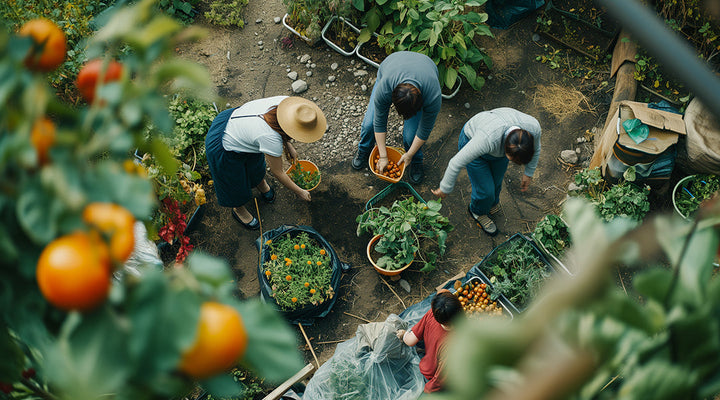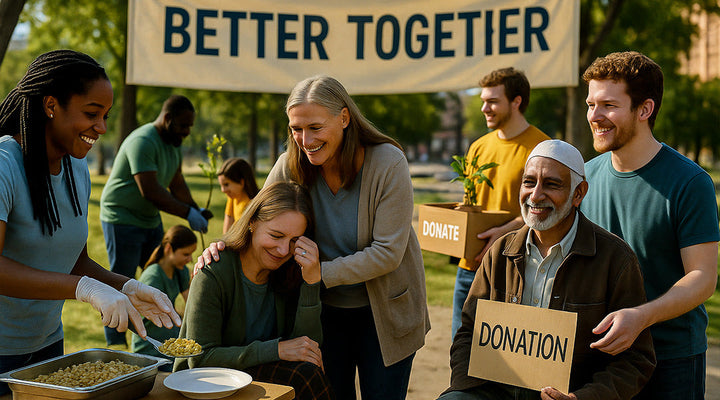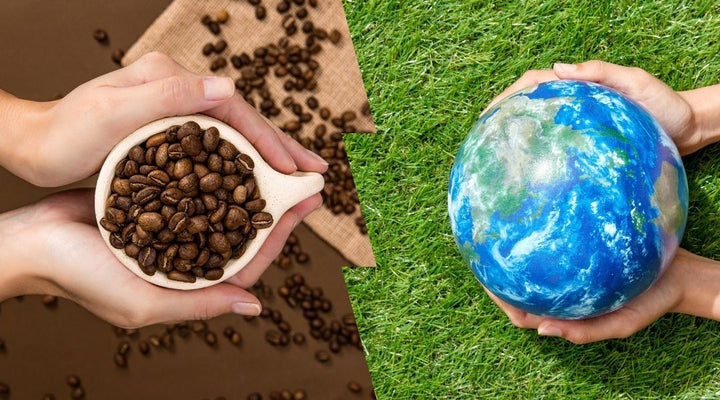
Wild About Coffee, Wild About Wildlife - Why Conservation Efforts Matter
If you have a pet, or two or three, you know how much joy animals can bring to your life.
But, have you ever thought about the impact the animal kingdom, as a whole, has on our planet?
As the human population grows, technology advances, and cities expand, it’s easy for us to go about our busy lives and actually forget, or take for granted, the fact that we (humans) are not the sole inhabitants of this world.
I mean, we love our pets. And, we enjoy trips to zoos and/or aquariums to see some of our planet’s majestic wildlife up close.
But, do we really understand the purpose and importance of wildlife?
And, do we understand the true impact ever-expanding societies, unsustainable farming practices, pollution, etc. has on these species?
Wildlife populations are an absolutely vital component of our lives, whether we realize it or not.
Even the elimination of a single species in an area can have widespread effects on plant life, animal life, and even the topography of the land.
Unfortunately, as of the year 2020, the World Wildlife Fund estimated “that the population of nearly 21,000 mammals, birds, reptiles, fishes, and amphibians had declined by an average of 68% within the last five decades.”
This rapid decline not only tells a dire tale for the fate of wildlife, but for our planet as a whole, and here’s why…
Understanding Ecosystems

The word ecosystem is a term used to essentially describe a relationship, a highly interconnected web including all living things dwelling within a specific area.
Plants, animals, humans, organisms - each of these co-exist within an ecosystem, interacting with one another and what we often refer to as ‘the elements’ (wind, rain, sunshine, etc.).
As all components of an ecosystem play their own, specific role in this environment, the health of even one part of an ecosystem can influence the health of the whole.
Perhaps this is an odd example, but I think cooking/baking or using recipes can paint a relatable picture of the delicate balance of an ecosystem.
In cooking or baking, each ingredient combines to essentially exist together, often creating a single item balanced by the combination of these individual ingredients.
Of course, each individual component has unique qualities that are needed in any given baked good or meal, and if you omit any one of these necessities, the end result is compromised.
Furthermore, the more items you omit or alter in a recipe, the worse the outcome will be.
Take cookies, for example, if you omit a small ingredient such as vanilla extract, this can slightly alter the taste of the baked good, even making it a bit drier.
Now, remove baking soda as well, and your cookies will likely have an undesirable consistency.
Then, try baking the same cookies without flour or sugar entirely, and you’ll soon find the recipe is ruined.
Of course, we may not think of our planet in this manner, but the reality is, it’s not much different than a delicious, freshly baked chocolate chip cookie.
When a particular ecosystem is left undisturbed, the plant, animal, and even human life in this area live together in harmony, each species benefiting from the other, each contributing to the overall health and wellness of the region.
But, when any one part of a specific ecosystem is disrupted, all of the inhabitants suffer, and the end result can be catastrophic…a much worse fate than a ruined cookie.
One of the greatest examples showcasing the importance of wildlife (in particular) to any ecosystem involves Yellowstone National Park.
Several years ago, we included bits of this experiment in an article, but I’d like to revisit this, perhaps a little more in depth, as it is likely one of the most profound instances highlighting the vital importance of wildlife populations to the health of any ecosystem.
Yellowstone National Park is one of many breathtakingly beautiful parks in the United States.
Within this protected region, plant and animal life exists together, allowing the park’s ecosystem as a whole to thrive.
But, in the early part of the 20th century, prior to 1914, mankind believed apex predators, such as wolves, were too much of a threat to other wildlife in the park and to humans living near these regions.
Because of this fear-fueled belief, an effort to remove the wolves began.
From 1914-1926, the 136 wolves living within the park were eliminated.
And soon after, mankind learned a vital lesson in the necessity of all wildlife in any given (natural) ecosystem.
Once the wolves were removed, Yellowstone underwent devastating changes.
“...elk and coyotes became overpopulated, and beavers disappeared. Elks overgrazed the land and trees, such as willow and aspen. Without those trees, songbirds began to decline. Beavers could no longer build their dams, and streams began to erode and degrade the conditions willow trees needed to grow. Without beaver’s dams and the shade from trees and plants, water temperatures were too high for cold water fish.”
Fast forward…

By 1973, with the passing of the Endangered Species Act, the gray wolf was one of the first species listed as endangered, meaning the protection and population recovery of wolves was now a mandate.
Then, in 1995 - yes, it took that long for efforts to become action - eight Canadian gray wolves were reintroduced into the park.
Since this time, the populations of elk and deer in Yellowstone have rebalanced.
With this balance, the aspen and willow trees have once again graced the Park’s landscape.
Even the songbirds have returned, along with eagles, beavers, badgers, and foxes.
Overgrazing has also ended, allowing the riverbanks to stabilize and the rivers to recover, some even flowing in new directions, bringing new life to other areas of this majestically beautiful ecosystem.
But, how can this be? How could the removal, and then the reintroduction of a single species have had such vast impacts?
Because wildlife is essential for maintaining balance and preserving biodiversity in any ecosystem.
From pollination to pest control, population regulation, and more, wildlife contributes vitally needed functions in our world.
“Predators…help regulate prey populations, preventing overgrazing and overpopulation of certain species.”
Then, “herbivores…play a vital role in shaping plant communities through grazing and seed dispersal, influencing the structure and composition of ecosystems.”
“Pollinators…facilitate plant reproduction by transferring pollen between flowers, ensuring the production of fruits and seeds.”
And, “decomposers…break down organic matter, recycling nutrients back into the soil and completing the nutrient cycle.”
Take away one of these, and the entire ecosystem is vulnerable to collapse, a gloomy situation conservationists believe we are eerily inching towards in today’s world.
What Is Wild About Wildlife Month?

In the example and explanation above, we’ve clearly seen how devastating the removal or extinction of even a single species can be to any ecosystem, and this is something wildlife conservationists are seeking to highlight through initiatives like Wild About Wildlife Month.
Wild About Wildlife Month began in 1984 as a way to not only celebrate wildlife but to also educate people regarding the challenges we’re facing on our planet, particularly those which threaten the needed balance between mankind, wildlife, and the environment as a whole.
Wild About Wildlife Month, observed each July in the United States, ultimately seeks to highlight the restoration and protection of wild animals in their native habitats.
And, such days or months serve as opportunities to not only highlight the importance of wildlife conservation but also educate us regarding how we can get involved, contribute, and make a meaningful impact towards a better planet and a better future for all of us - wildlife included!
The efforts surrounding Wild About Wildlife Month, especially in our day and time, remind us that animals need us.
And as we saw with the wolves, awareness/education is only a small step, and action can take a long time to come to fruitful fruition.
That’s why it’s so important to protect and preserve, to let our knowledge of the importance of wildlife to ecosystems all around the world prompt us to make a change, to act - from legislative efforts to individual actions and company commitments, now is the time, more than ever, for us to answer the call for environmental change.
And, here’s what those changes, that action, looks like for Lifeboost Coffee…
The Lifeboost Wildlife Connection

Coffee is one of the most widely consumed beverages, not just in the United States, but all around the world.
Unfortunately, this can spell doom for wildlife.
How?
Well, most conventionally grown, mass-marketed, coffee is grown without giving a second thought to our planet’s fragile ecosystems, including the wildlife living in the regions where a lot of coffee is grown to meet global demand.
As many of you may already know, these conventional growing methods involve massive deforestation. In such instances, specific areas of land are cleared entirely, completely eradicating the habitats any and all wildlife in the area depend upon for food, shelter, water, and ultimately survival.
Then, these crops are heavily treated with fertilizers, herbicides, pesticides, and more which leech into nearby waterways and wreck the soil for years to come, once again either killing off or forcing the removal of much of the wildlife in the region.
As you can imagine from the example of the wolves in Yellowstone, the repercussions of this loss of habitat and thus relocation or eradication of the area’s wildlife cause devastating changes to the ecosystems in these regions.
Even worse, these practices are unsustainable, meaning within several years, the soil becomes so degraded that growers must move their operations to new areas, where the entire ecosystem disrupting/destroying process begins again.
But, here at Lifeboost, we do things differently!
We don’t just put the health of our customers (and thus our coffee) at the forefront of all we do, we also believe the health of our planet (including wildlife) is just as important!
This is why we simply cannot grow coffee in this manner.
With great tasting, clean coffee, the health of our customers, and the health of our planet in mind, we are happy to say that our sustainable growing practices actually increase biodiversity in the areas where our coffee plants are grown.
Lifeboost Coffee farmers grow our beloved beans on their small family-owned plantations high in the protected regions of the rainforest mountains of Nicaragua.
Growing coffee in these areas ensures no ecosystems are ever harmed or destroyed.
Instead, our coffee plants are grown amongst native, surrounding plants, a practice which not only provides natural shade for our coffee shrubs, but also increases the nutrient density of the soil.
Even better, by adding this source of life (coffee shrubs) to the already flourishing landscape, this brings in new pollinators and other insects.

And, the new pollinators and insects then bring birds and other small rodents to the area.
This in turn brings in larger predators which hunt the birds and small rodents, and in the end, the entire ecosystem is enhanced due to the increase in biodiversity.
Now, I’m sure you can see how the use of pesticides, fertilizers, and other harsh chemicals would wreak havoc on this environment, now teeming with pollinators, prey, and predators, but there’s nothing to fear here, as we never use these on our coffee plants.
Instead of incorporating the conventional method of spraying coffee shrubs with such chemicals, the healthy ecosystem here acts as a ‘team,’ allowing the wildlife in the area to work in harmonious tandem with the coffee shrubs and surrounding plants.
Birds and other wildlife eat any insects that would pose a threat to our coffee plants. And, decomposing leaves from nearby vegetation combined with animal waste serve to fertilize the soil where our plants are grown.
But, our sustainable coffee growing methods are only the beginning of our planetary passions.
To add to these ecosystem enhancing measures, Lifeboost also supports the Rainforest Trust, an organization which is actively protecting our world’s rainforests.
Nearly “50% of the world’s biodiversity is found in rainforests.” And to date, the Rainforest Trust, through charitable support, has protected 55 million acres across the globe, protecting 3,335 endangered species in the process.
Rainforest Trust CEO James Deutsch has said, “protecting land is the critical first step in halting extinctions and stabilizing our climate. It can only happen through partnerships, and Rainforest Trust is committed to helping replicate this success worldwide.”
Apart from the Rainforest Trust, we also use EcoCart which has more than offset our carbon emissions, another ecosystem protective measure we’re passionate about.
But, perhaps the most direct link to wildlife we’re excited to enjoy at Lifeboost relates to our adopted Lifeboost Team Members - Coffee Bean, an endangered Ugandan giraffe, and Cinta, a Sumatran tigress.
Adopting these wildlife wonders aids in their protection as well as the preservation of their habitats, and it allows us to join in efforts to raise awareness, fund conservation efforts, and encourage ecosystem protection across the globe.
Thinking back to the wolves in Yellowstone National Park, Defenders of Wildlife describe the effects of the wolf reintroduction as not only successful, but “a victory for humans and our planet…The mistake originally made with the gray wolf was a big one, but our effort to correct that mistake is a beacon of hope.”
And, this beacon of hope is what we hope to represent to each of you.
There have been many mistakes made as our societies have expanded and demand for a wide variety of products has increased, but this doesn’t have to be the end of our planet’s story!
Like the reintroduction of the wolves to Yellowstone, our planet can potentially heal as conservation efforts increase and awareness spreads.
In fact, more and more coffee connoisseurs are seeing the damage done with conventional growing methods, prompting a wave of concern, leading consumers to seek out clean, healthy, planet-friendly (and thus wildlife-friendly) coffee, like Lifeboost.
Because when you sip Lifeboost Coffee, you can rest assured that no ecosystem, nor the wildlife which bring needed balance to it, are hindered or harmed in the making of your ‘cup.’
And, to top it off, a portion of our proceeds are used towards conservation efforts as well as reducing our carbon footprint, making you, our customers, real partners in thosgening all across the globe.
So, join us in celebrating Wild About Wildlife Month with a few extra mugs of Lifeboost this month, and spread the word amongst your family, friends, and colleagues regarding the challenges our planet’s fragile ecosystems face when wildlife is threatened.
Check out Lifeboost Coffee Grata Medium Roast .

Becky is a mother, educator, and content writer for Lifeboost Coffee. She has had three years’ experience as a writer, and in that time she has enjoyed creatively composing articles and ebooks covering the topics of coffee, health and fitness, education, recipes, and relationships.
- https://nationaltoday.com/wild-about-wildlife-month/#history
- https://wildlifeforall.us/civicrm/mailing/view/?id=1163&reset=1
- https://australian.museum/learn/species-identification/ask-an-expert/what-is-an-ecosystem/#
- https://defenders.org/blog/2020/03/we-were-wrong-about-wolves-heres-why#
- https://www.tigersafariindia.com/blog/why-conservation-matters-preserving-the-wildlife/#
- https://www.rainforesttrust.org/
- https://www.endangered.org/how-symbolically-adopting-wildlife-helps-endangered-species/
- References for the article to confirm data and information.










